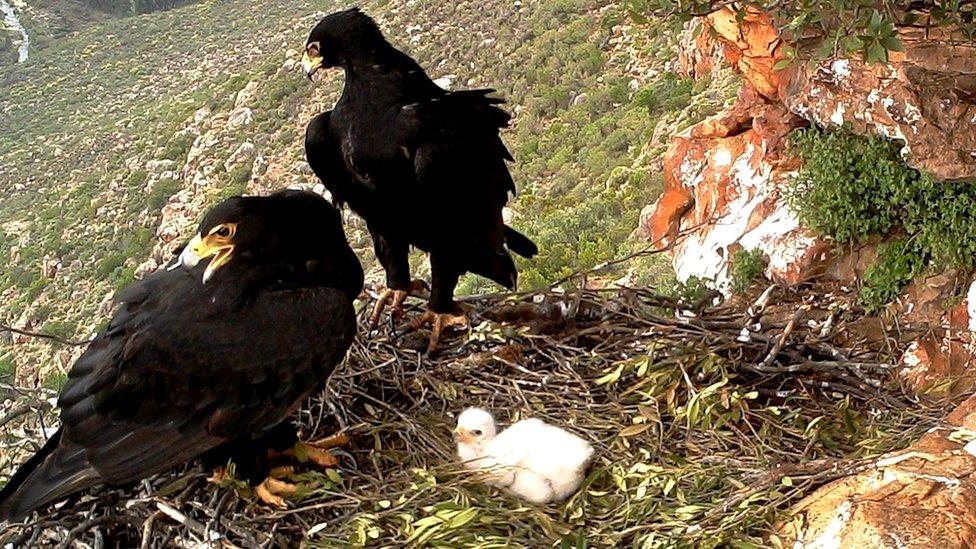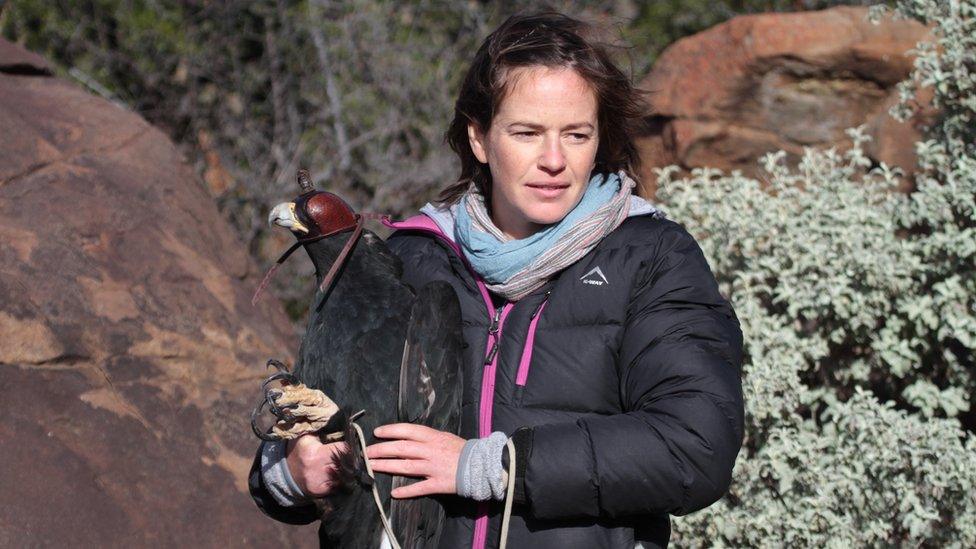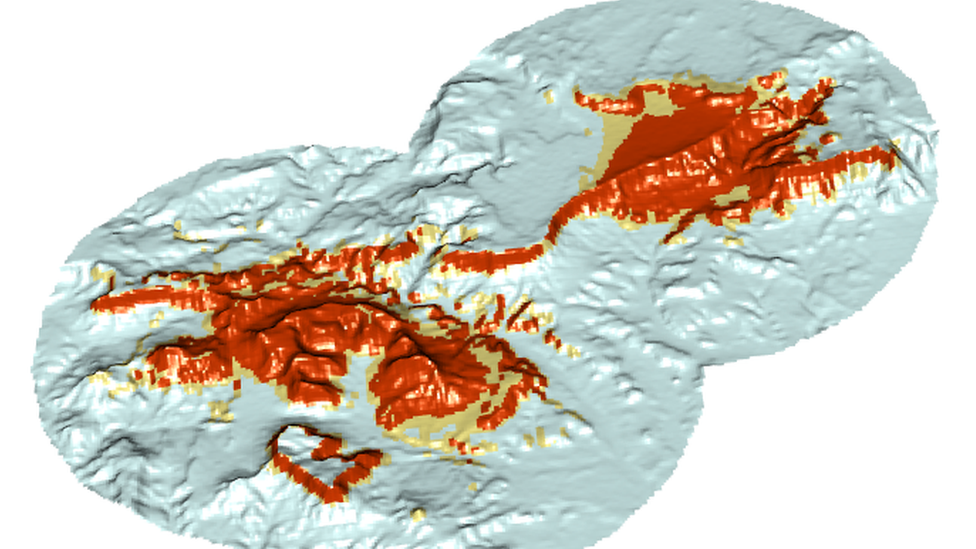How to protect birds and bats from wind turbines
- Published

South eastern Africa is the heart of the Verreaux's eagle range
South Africa's Verreaux's eagles have a problem. The very landscapes they favour, where the air currents along vast ridges carry them as they soar, are prime locations for wind farm developers - who want to make use of exactly the same resource.
"At least 24 carcasses have been picked up under wind turbines," says Dr Megan Murgatroyd, from Hawkwatch International. "For this species in particular, it seems to be quite a conflict."
Sometimes the birds die when they collide with the swiftly spinning blades of the turbines, which are difficult for them to see. Or, they get electrocuted by power lines at the wind farms.
Dr Murgatroyd is on a mission to stop this happening and she's decided to work with wind energy companies in order to find ways of reducing fatalities.
Around the world, wind energy on and offshore is gathering momentum. In May, the International Energy Agency announced that the amount of wind energy capacity added worldwide in 2020, 114 GW, was nearly double the additions made in 2019, external.
But many worry that not enough is being done to prevent the deaths of thousands of animals, even though the rise of renewables is generally seen as good news in the fight against climate change.
That was underlined just days ago when a bearded vulture, released into the wild last year in southern France, was killed by a wind turbine, external after it ranged north into the Netherlands.

Dr Megan Murgatroyd and colleagues have developed a tool to determine where eagles are most likely to fly
To help Dr Murgatroyd and her colleagues have come up with a commercial tool that tells developers, external where Verreaux's eagles are most likely to fly within a given area so that the firms can position their wind turbines away from those places.
It's based on tracking data she collected after fitting GPS devices to more than a dozen eagles. The tool also needs to consider where eagle nests are located, so surveys to plot these must be carried out in and around any land earmarked for new wind turbines.
To try and validate the tool's recommendations, Dr Murgatroyd has used it to analyse the locations of wind turbines that were built before the technology was available. This revealed that many eagle fatalities associated with those turbines occurred in places that the model would correctly have labelled as high risk.
"If the model had been used, up to 79% of [those deaths] could have been avoided," she says.

An eagle's flight track
Not all wind farm developers in South Africa are using the software but she hopes that those who do will end up recording fewer bird deaths on their properties. She also plans to expand the technology so it can evaluate the risks facing other bird species, including the critically endangered black harrier.
Estimates of how many bird or bat deaths are caused by wind turbines each year vary, though they are certainly in the many thousands, if not more.
As BBC News reported in 2019, scientific studies show that fossil fuels are associated with the deaths of far more animals. Domestic cats are significantly more deadly, also, external.
However, among those who think we shouldn't dismiss the impact of spinning blades is Dr Christian Voigt at the Leibniz Institute for Zoo and Wildlife Research in Berlin.
He occasionally visits wind farms to see if dead bats are present on the ground.
"I actually find carcasses quite often," he says. "That tells me something's going wrong here."
Dr Voigt and his colleagues have studied the effectiveness of existing technologies used to monitor the presence of bats on wind farms. This is usually done by placing a single, downward-facing microphone at the central point where a turbine's blades meet.

Dr Christian Voigt says he finds bat carcasses "quite often" at wind farms
In Germany, surveys that detect bats in this way are used to establish the weather conditions associated with bat activity around newly built turbines. That way, the turbines can be halted - curtailed - when those same conditions arise in the future, to protect any bats that might come by.
Yet this approach could be fundamentally flawed, says Dr Voigt. It turns out that the individual microphone, which picks up bats' ultrasonic calls, can't detect the creatures, external as comprehensively as hoped. Some bats have particularly quiet, high frequency calls that don't travel very far.
Dr Voigt estimates that, on average, each wind turbine kills about 10 bats every year.
"There is a clash between protecting biodiversity and protecting the climate," he says.


The industry body Wind Europe says that it takes environmental protection "very seriously" adding that "we look at the impacts of individual wind farms as well as their cumulative, long-term impacts, and do everything we can to manage and mitigate them".
Wind Europe says wind farm developers in Europe meet the requirements of various environmental regulations.
New technologies are arriving to help wind farm operators curtail their turbines and protect wildlife.
In recent years a wind farm in Wyoming has trialled a system called IdentiFlight, which uses a camera-based monitoring system to automatically detect the presence of eagles and shut down the turbines in order to prevent accidents occurring.
A study published in January found, external the system reduced eagle fatalities at the site by 82%.
There are even radically different turbine designs in the works, such as the bladeless concept from Spanish firm Vortex. Instead of spinning blades, the turbines are more like pillars that quiver in the wind. Vortex claims they are "harmless" to birds, bats and insects.
"You could stop the movement of a small vortex device with your bare hands with no harm, so risks are reduced drastically," says the firm.
While technological interventions may help, many argue the best approach is simply to place wind farms in the least sensitive areas. And to continue monitoring the extent to which wildlife is at risk.
A radar-based study, external of an offshore wind farm near Thanet, published in 2018, found that nearly 97% of seabirds actually avoided those turbines.
A similar study, off Aberdeen, is set to report its results in the coming weeks, according to a Vattenfall spokeswoman.

A map of the risks to eagles in South Africa
Dr Chris Thaxter at the British Trust for Ornithology, whose research has sometimes been funded by wind energy firms, says he and colleagues have found that birds are far more at risk along migratory routes. It's possible to be smart about where you position wind turbines, he adds.
"Ultimately, we need to build these things because it's going to be an important component of combating climate change," he says.
Dr Murgatroyd agrees: "I personally believe that we should be using a good mixture of all of these alternative things, whether it's wind or solar. But I do think it needs to be done with a lot more care."